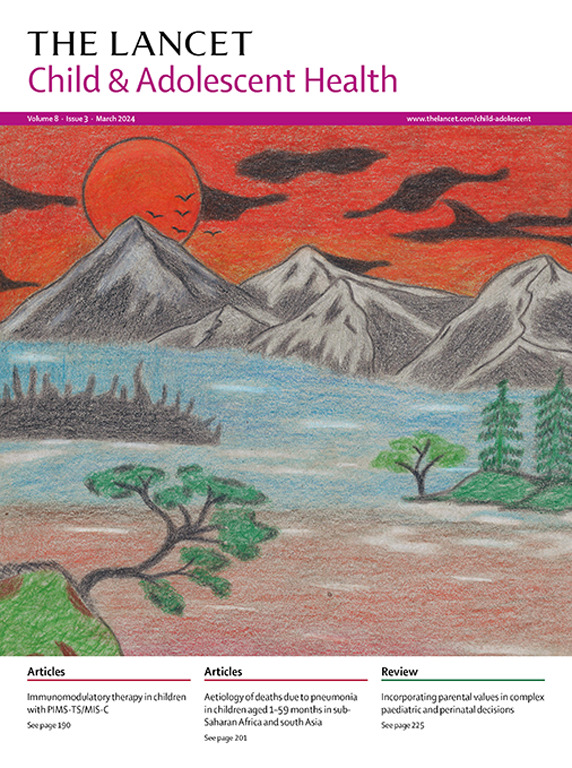Timing of repeat epinephrine to inform paediatric anaphylaxis observation periods: a retrospective cohort study
IF 15.5
1区 医学
Q1 PEDIATRICS
引用次数: 0
Abstract
Background
Children presenting to the emergency department with anaphylaxis typically receive at least one dose of epinephrine and are observed in the emergency department or monitored for recurrent (biphasic anaphylaxis) or persistent symptoms on hospital wards for variable durations before discharge is considered safe. We aimed to calculate the incidence rate and timing of repeat epinephrine dosing to determine the observation threshold at which the cumulative incidence of repeat epinephrine was less than 2% for every 1 h increase in observation time.
Methods
This multicentre, retrospective cohort study across 30 emergency departments in the USA and one emergency department in Canada included children aged 6 months to 17 years who, according to electronic medical records, presented to one of the participating emergency departments with an acute allergic reaction that was treated with intramuscular, subcutaneous, or intravenous epinephrine before arrival at the emergency department or in the emergency department between Jan 1, 2016, and Dec 31, 2019. We excluded patients who had no documentation of symptoms or examination findings before presenting to the emergency department, were transferred from outside health-care facilities, had reactions secondary to medications administered in the emergency department, or had comorbidities requiring tailored management decisions. Demographics, medical history, and emergency department revisits within 72 h of discharge were extracted from electronic medical records. The primary outcome was the time from first to last administration of epinephrine. For patients on intravenous epinephrine infusions, the relevant time interval was from infusion initiation to discontinuation. Kaplan–Meier analyses were used to compare time to last epinephrine dose by initial reaction severity, stratified by respiratory and cardiovascular involvement (no respiratory or cardiovascular involvement, respiratory but no cardiovascular involvement, and cardiovascular involvement).
Findings
Of 7717 patients with ICD-10 Clinical Modification codes for anaphylaxis, 5641 were eligible for inclusion (median age 7·9 years [IQR 3·3–13·1]; 2475 [43·9%] female; 3166 [56·1%] male). Of the 5139 patients who reported ethnicity, 1131 (22·0%) identified as Hispanic and 4008 (78·0%) identified as non-Hispanic. 263 (4·7%) of 5641 patients received a repeat epinephrine after 2 h of the first dose, whereas 109 (1·9%) received repeat epinephrine after 4 h, 64 (1·1%) after 6 h, and 46 (0·8%) after 8 h. The observation period at which the increase in cumulative incidence of repeat epinephrine was less than 2% was 115 min (95% CI 105–122) for all patients, 105 min (54–135) for patients without respiratory or cardiovascular involvement (n=1070), 109 min (98–118) for patients with respiratory but no cardiovascular involvement (n=4076), and 161 min (125–249) for patients with cardiovascular involvement (n=495). These findings suggest that 5378 (95·3%) patients in our cohort would have been safely discharged 2 h after receiving the first epinephrine dose and that 5532 (98·1%) patients would have been safely discharged 4 h after the first epinephrine dose.
Interpretation
A 2-h observation period is probably safe for most children who present to an emergency department with an acute allergic reaction requiring epinephrine. A 4-h observation period might be enough for patients with cardiovascular involvement who appear well.
Funding
The National Center for Advancing Translational Sciences and The National Institute of Allergy and Infectious Diseases of the National Institutes of Health.
重复肾上腺素的时间通知儿科过敏反应观察期:一个回顾性队列研究
背景:以过敏反应就诊于急诊科的儿童通常接受至少一剂肾上腺素,并在急诊科观察或监测复发(双期过敏反应)或在医院病房持续不同时间的症状,出院前被认为是安全的。我们的目的是计算重复肾上腺素给药的发生率和时机,以确定观察时间每增加1 h,重复肾上腺素累积发生率小于2%的观察阈值。方法:这项多中心、回顾性队列研究涉及美国30个急诊科和加拿大1个急诊科,研究对象包括6个月至17岁的儿童,根据电子病历记录,这些儿童在到达急诊科之前或2016年1月1日期间因急性过敏反应向其中一个参与的急诊科就诊,并接受了肌肉注射、皮下注射或静脉注射肾上腺素治疗。2019年12月31日。我们排除了在到急诊科就诊前没有症状记录或检查结果的患者,从外部医疗机构转来的患者,在急诊科使用药物后发生反应的患者,或有合并症需要量身定制的管理决策的患者。从电子病历中提取了人口统计、病史和出院后72小时内的急诊科就诊情况。主要观察指标为肾上腺素第一次到最后一次给药的时间。对于静脉输注肾上腺素的患者,相关时间间隔为开始输注至停止输注。Kaplan-Meier分析采用初始反应严重程度,呼吸和心血管受累(无呼吸或心血管受累,呼吸但无心血管受累,心血管受累)分层,比较时间至最后肾上腺素剂量。在7717例符合ICD-10过敏反应临床修改代码的患者中,有5641例符合纳入条件(中位年龄7.9岁[IQR 3.3 - 13.1];女性2475人[43.9%];3166[56·1%]男性)。在5139例报告种族的患者中,1131例(22.0%)确定为西班牙裔,4008例(78.0%)确定为非西班牙裔。5641例患者中,263例(4.7%)在第一次给药2小时后接受了重复肾上腺素治疗,109例(1.9%)在第一次给药4小时后接受了重复肾上腺素治疗,64例(1.1%)在第一次给药6小时后接受了重复肾上腺素治疗,46例(0.8%)在第一次给药8小时后接受了重复肾上腺素治疗。所有患者重复肾上腺素累积发生率增加小于2%的观察时间为115 min (95% CI 105 - 122),无呼吸或心血管受累患者为105 min (54-135) (n=1070)。无心血管受累的呼吸系统患者(n=4076) 109分钟(98-118分钟),有心血管受累的患者(n=495) 161分钟(125-249分钟)。这些结果表明,在我们的队列中,5378例(95.3%)患者在接受第一次肾上腺素剂量后2小时安全出院,5532例(98.1%)患者在接受第一次肾上腺素剂量后4小时安全出院。对于大多数因急性过敏反应需要肾上腺素就诊的儿童来说,2小时的观察期可能是安全的。4小时的观察期对于出现良好的心血管疾病患者可能足够。资助国家促进转化科学中心和国立卫生研究院国家过敏和传染病研究所。
本文章由计算机程序翻译,如有差异,请以英文原文为准。
求助全文
约1分钟内获得全文
求助全文
来源期刊

Lancet Child & Adolescent Health
Psychology-Developmental and Educational Psychology
CiteScore
40.90
自引率
0.80%
发文量
381
期刊介绍:
The Lancet Child & Adolescent Health, an independent journal with a global perspective and strong clinical focus, presents influential original research, authoritative reviews, and insightful opinion pieces to promote the health of children from fetal development through young adulthood.
This journal invite submissions that will directly impact clinical practice or child health across the disciplines of general paediatrics, adolescent medicine, or child development, and across all paediatric subspecialties including (but not limited to) allergy and immunology, cardiology, critical care, endocrinology, fetal and neonatal medicine, gastroenterology, haematology, hepatology and nutrition, infectious diseases, neurology, oncology, psychiatry, respiratory medicine, and surgery.
Content includes articles, reviews, viewpoints, clinical pictures, comments, and correspondence, along with series and commissions aimed at driving positive change in clinical practice and health policy in child and adolescent health.
 求助内容:
求助内容: 应助结果提醒方式:
应助结果提醒方式:


